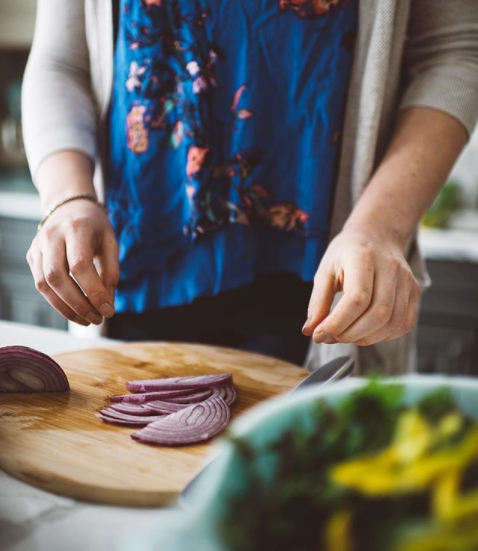Sometimes it can seem like we all desire to get healthy—right now—and that we want to stay healthy forever and ever without another look at the process.
Just eat enough blueberries and we’ll get there, right?
As a Nutritional Therapy Practitioner, I’ve noticed a few recurring themes in my work with clients, and I think they merit extra dialogue in these shaky days of general turmoil and unease in the world. So many of us are working diligently to be the truest versions of ourselves: perhaps meal prepping up a storm, following the best thought leaders, and researching the ins and outs of nutrition.
It’s commendable—and yet, why do we sometimes feel like at best, we’re just spinning our wheels, and at worst, we’re going in reverse when it comes to our health and wellness?
The nutrition tips I’m offering don’t outline how to get more kale into our lives, or how Niacin (Vitamin B3) is the key to a swell life—though I do encourage people to understand that nutrition knowledge is power. Parceling out specifics on macronutrients and micronutrients is great when it comes to certain nutritional needs, but that can only take into account half of the relationship with the food on our plates.
What else might we utilize in order to keep our lovely bodies trucking along, fueled by whole, natural foods, and able to use those foods for the highest benefit?
Let’s check out how we can incorporate an emphasis on our physiological states in conjunction with eating those fresh, unprocessed foods for happiness and health. First, we should discuss our two main physiological states:
The Sympathetic State
The sympathetic state is the body’s stress state—also known as fight, flight, or freeze. This can occur on a spectrum of intensity depending on what stimulus we’re encountering; traumatic experiences versus annoying commuter traffic will have different lasting effects on us, but our physiology will still recognize these both as stressors. If we step back and assess how we navigate our world in the modern era, it can start to become apparent that during many parts of our day, we’re navigating this sympathetic state.
This stress becomes cumulative over time. When our bodies are in stress mode, they don’t regulate digestive and healing functions since back in the day (way, way back in the day), sending blood to our intestines to fully digest our lunch wouldn’t have saved our lives if we were being chased by an animal and targeted as lunch. The sympathetic mode instead primes our bodies to get the blood pumping in our hearts and extremities, and amps up cortisol and adrenaline levels, all so we can run away quickly. Once we survive that stressful event, then we can finish digesting our food.
The Parasympathetic State
The parasympathetic state is when our bodies are relaxed and ready to fully digest our food, tap into innate creative pathways, promote healing, and connect deeply with others. In the parasympathetic state, our bodies are getting the signal through our environment (and how we interact in that environment) that it’s okay to dedicate resources toward these less lifesaving, yet highly restorative, bodily functions.
Historically, our bodies likely were allowed to be in this parasympathetic state much more frequently than our modern culture allows. These days, we have more emotional, spiritual, social, and financial burdens and expectations placed on us than ever before. Add into this our enormous drive for independence and less emphasis placed on community and support, and we can start to see the picture we’re painting for ourselves.
So now that we know the difference between the sympathetic and parasympathetic states, how do we integrate these concepts to build our nutritional base? As you’ll read below, creating emphasis on the parasympathetic mode can be a beautiful way to return to the grounding and sustaining knowledge our bodies already intrinsically house.
1. Getting caught up in joy rather than numbers.
Numbers, goals, the scale, the measuring tape—they can have a place in our wellness journey and they can provide quantifiable evidence of changes taking place. In terms of coaching, this is awesome. But what happens when keeping score for your body stops being a short-term practice and suddenly we step back and realize we’ve been tracking numbers for years? Sounds stressful.
If this resonates, as it often can for many on the wellness journey, one thing we can try is asking ourselves: does this practice bring me happiness right now? The lifestyle changes that we keep long-term are the ones that improve our quality of life. We can ask ourselves if doing five workouts each week when starting a new exercise protocol is what we want to integrate into our lives, or if it would feel better long-term to do two workouts per week, skip out on the burnout, and actually feel excitement each time we work out. What if instead of telling ourselves we’ll be “good” all week (and what does “good” even mean?) when it comes to our food intake, we think about the foods we know help us feel better during the day and we focus on that? What happens if we allow ourselves to choose activities that don’t feel like punishment, but instead actively take stress away?
2. Thinking in terms of addition rather than subtraction.
Many of us have played around with different types of nutrition styles, especially over the past few years as more ancestral styles of eating have grown in popularity. After 21, 30, 60, or even 90 days of eating this way, what comes next?
Did we feel amazed by how integrated we felt in our bodies during that initial experience, but now we’re out to sea, knowing that when we removed x, y, and z our bodies felt good, but our minds said, “But, seriously, we can’t eat that way for forever!?” If we’re feeling like our wellness is in an all-or-nothing stage, we may still be coming from a restriction mindset. If we’ve played around with foods that make us feel well, we now have the amazing ability to define which foods support our abundantly unique style of eating.
Focus on bringing in the tummy-pleasing, restful, and nourishing stuff without worrying about the others foods that don’t quite fit that bill right now, and we might just see that dabbling in the grey area is okay, and in fact, is a totally cool place to be. Feeling like those nourishing foods are our fallback foods, instead of a punishment, we can see what shifts begin to happen in our bodies. When we can come from a place of abundance instead of scarcity, we signal to our bodies that they are safe—and we come back to our parasympathetic state.
3. Supporting changes within our bodies—rather than fighting them.
Often when we feel frustrated by a “lack of results,” what we may be noticing is a disparity between our expectations and reality. A better way to deal is by noticing and acknowledging the changes we’ve seen in ourselves and using those to propel us forward.
When actions geared toward creating change butt against a sympathetic state, typically those changes will integrate less fully within our bodies. This means results can happen, but typically won’t stick around long-term since we’re too stressed out to keep up with however we got to that point. Sounds frustrating, right?
I truly believe our bodies hold all the answers within, and if we can meet them where they’re at in a non-stressed state, they typically will guide us much more readily than when we try to force them to change. Deep belly breaths during times of frustration can signal to our bodies not only that they’re in a safe place to be engaging in deep breathing (therefore guiding ourselves back into that parasympathetic state), but that we can access feelings of frustration from a place of abundance and be able to move forward with those feelings with curiosity instead of shame, guilt, or blame.
As we continue moving forward and making plans, goals, or simply trying to shift toward fostering more wellness, I hope these three ideas support each of our unique needs, encouraging practices that are geared to changing nutrition and fitness from being strict and didactic to more tangible and integrated practices that provide authentic wellness for us all.
~
~
Author: Lucia Hawley
Image: Author’s own
Editor: Nicole Cameron
Copy Editor: Catherine Monkman

 Share on bsky
Share on bsky







Read 5 comments and reply